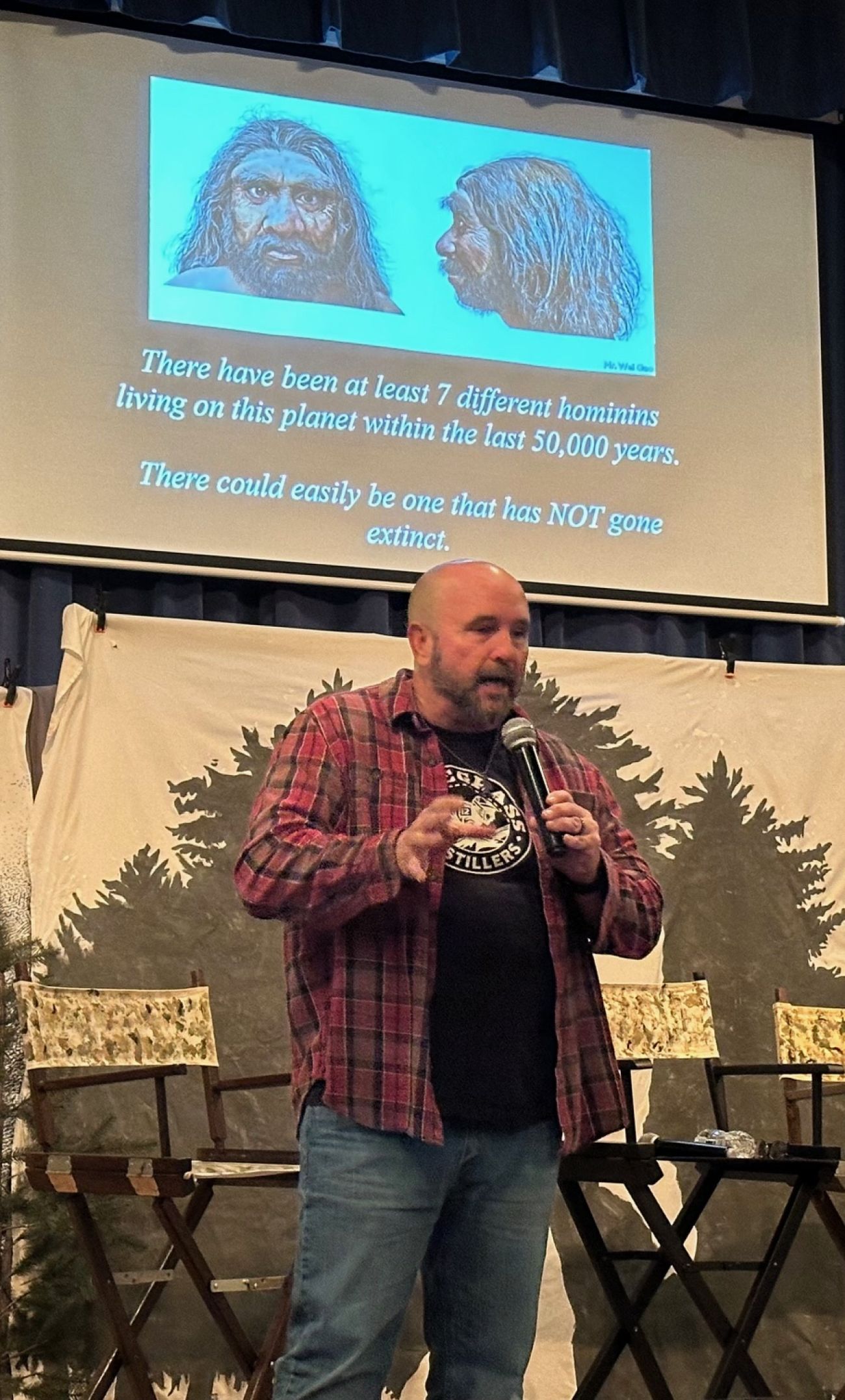In Michigan’s north woods, a search for Bigfoot and political common ground

- Amid the presidential election, 200 true believers make their way to Oscoda to learn about Bigfoot
- Belief in such cryptids has increased, polls say, as trust in institutions has decreased
- Just as in politics, true believers don’t listen to skeptics enough, leading to confirmation bias
OSCODA — Red beams from a dozen head lamps danced across oak, birch and white pine somewhere in a national forest near Oscoda. The exact location for the night hike was closely guarded, to keep away crowds that might scare Sasquatch.
Tickets were limited for the event, which was part of this month’s Bigfoot conference in Oscoda. Some participants said they already had encounters with the beast, while others hoped to catch a glimpse on this windy night.
Leading the hike was Ranae Holland, co-host of the show “Finding Bigfoot,” which ended in 2017 but is still broadcast in cable reruns. A research biologist from the Pacific Northwest, she feels most at home in the woods, close to nature — if not to the creature that, even after decades of research, she has doubts exists.
Coming to Michigan less than a month before the presidential election, Holland can’t help but find parallels between the echo chamber that has convinced millions that there is a living, breathing beast hiding in the woods, and the political bubbles widening the divide between Americans.
“I have been in this (Bigfoot) community for 15 years,” Holland said, “and I constantly tell people, if you aren't having conversation with people you disagree with, if you're drinking the Kool Aid and watching the same channel and getting your information from the same place, you're doing yourself a disservice.’”

But the deeper into the forest Holland led her group of eager explorers, the farther she felt from the things that in recent years were giving Bigfoot a bad name — the online forums littered with fake videos and debunked evidence, and the cynics trying to make a buck on the back of their distant, hairy cousin.
Holland stopped in her tracks and cocked her head to the right, and her Bigfoot apprentices fell silent.
“Did anyone hear that?”
‘Keep an open mind’
To be clear, there is no proof that Bigfoot exists. No Sasquatch has been captured, photos are rare, blurry and often fake, and there are no collections of bones to study. The same goes for the Yeti in the mountains of Tibet, and all of Bigfoots’ cousins here in the U.S., from the Skunk Ape in the Everglades, to Grassman in Ohio, to the Wood Booger in Virginia.
That hasn’t stopped 1 in 8 Americans from believing in Bigfoot. For perspective, that’s about the same ratio as the Millennials who prefer communism to capitalism, but a smaller ratio as voters who believe Joe Biden is in the White House because of fraud (1 in 3).
Social scientists say belief in Bigfoot — and other so-called conspiracy theories — have increased since 2020, as trust in institutions has declined and reinforcement from social networks has increased.
Whatever the case, Michigan is a hotbed for believers, if sightings tallied by the Bigfoot Field Researchers Organization are to be believed. The group claims there have been 225 encounters in the state since the late 1970s, the seventh most in the nation. Illinois (303) and Ohio (326) have more.
Related:
- Michigan history and the EV future collide at a UP snowmobile museum
- Michigan’s EV evangelists luring 'fence-sitters' away from gas cars
- Miniature museum in northern Michigan offers wacky take on taxidermy
There have been recorded encounters in 67 Michigan counties. Iosco County in northeast Michigan, where last weekend’s conference was located, has had six encounters reported to the organization, with the most recent in 2016 and 2017.
The conference was held at the Shoreline Players Theater, where a musical adaptation of “The Addams Family” is in rehearsal when Bigfoot enthusiasts aren’t in town. Outside the theater, vendors marketed sexually suggestive Bigfoot T-shirts (“You know what they say about Big Feet”), Sasquatch windsocks, and chocolate-covered caramels relabeled for the weekend as “Bigfoot droppings.”

Inside, Charlie Raymond, founder of the Kentucky Bigfoot Research Organization, told an audience of about 200 that, despite the lack of indisputable evidence, Bigfoot is out there.
“It is a yet-to-be classified hominid that lives and breeds in the forest,” Raymond declared. “Maybe the government knows. There are government cover-ups. My wife believes the moon landing was fake.”
The real question, Raymond said, isn’t whether a species of big apes exists in Michigan forests, but what we need to do to “preserve them.”
“If Bigfoot is ever discovered, it’s a dilemma,” said the former middle school math teacher. “Whose land is it, ours or theirs? If Bigfoot has feelings and empathy, consider the controversy there.”
Many of those in the audience nodded in agreement. “Why couldn’t it be true?” said Geena Altheide, wearing a T-shirt emblazoned with a Sasquatch wearing an American flag bandana. “They find new species all the time.”
Marc DeWert is a longtime Bigfoot researcher who runs an Ohio Bigfoot Conference that draws about 4,000 curious and serious believers annually. He acknowledged that some Sasquatch enthusiasts are too quick to attribute any strange occurrence near trees to a mysterious ape.
“Some of these nut jobs really saw something,” he said, but some, maybe most, Bigfoot claims are sketchy.
“With my forestry job, I’m in the woods 300 days a year,” DeWert said, “and if I see something that could have a connection to Bigfoot two times, I’m lucky.”
DeWert, Holland and other longtime Bigfoot experts say many Bigfoot believers start by having seen something weird in the woods, and wanting to prove to themselves and others that they’re not crazy.
“Some of these nut jobs really saw something.”
— Marc DeWert, a longtime Bigfoot researcher
Others are attracted by the mystery – those who want to believe.
Either way, large apes have appeared in folklore for centuries in various cultures, particularly in Native American folklore on the American west coast.
“It’s easy to assume … that people who believe in Bigfoot are being irrational in their belief,” Lynne McNeill, a Utah State University folklore professor, told the Cal University Alumni Association magazine. “But that’s really not true. People aren’t jumping to supernatural conclusions very often; people are being quite rational. It doesn’t mean they’re correct; it just means they’re thinking rationally.”
Holland had been the skeptic among four co-hosts on “Finding Bigfoot.” Still, there were experiences she couldn’t explain. There was the time something poked her in the back in her tent; on another trip into the woods, she saw red eyes peeking at her from behind a tree.
“Whether you vote red, white, blue or don't vote, or whether you believe in Bigfoot or aliens, here’s what I say to people: Do your research. And learn from others.”
— Ranae Holland, co-host of the show “Finding Bigfoot.”
Most reported encounters could be explained away, probably including the distant noise Holland heard in the pines on the Friday night hike that sounded like a child’s voice in the woods.
Another member of the hike told Holland she heard the same thing.
“It’s probably not Bigfoot,” Holland said, “but keep an open mind.”
A hiker pulled out a wooden club, and Holland demonstrated how to strike it on the side of a tree. It’s a way to get the attention of any Bigfoots in the area, and, hopefully, get them to respond.

After the hiker gave a tree trunk three whacks, the group stood in silence for a few minutes, listening for a reply.
Nothing.
Holland tried a Bigfoot call, a loud, long whoop. More waiting for a reply.
Nothing.
One member of the hike scanned the woods with an infrared camera, which captures thermal images of bodies that give off heat, like mammals.
Nothing.
Commercializing Bigfoot
Jeff Meldrum is the serious face of sasquatch research, a professor of anatomy and anthropology at Idaho State University who beyond teaching organic evolution classes is known for having the world’s largest collection of what he says are Bigfoot footprint casts.
At the conference, he sat at a table selling field guides detailing how to collect data on Bigfoot, and an academic-style tome on the latest sasquatch research, titled “Sasquatch: Legend Meets Science.”
Meanwhile, nearby tables were selling bigfoot dish towels and keychains. A person dressed in a Spirit Halloween-quality Bigfoot costume ordered a slice of Hungry Howie’s pizza.
“I make no apologies for speaking at events like this, if I can elevate the level of discussion and the powers of discrimination of the people involved,” Meldrum said. “I mean, I'm all for citizen science.”
But science, from citizens or professors, isn’t as easy as it used to be, lamented the 66-year-old.
Bigfoot, he said, has become too commercialized.
“There are many, many people who are motivated not out of a sincere interest in the subject, but as a means for monetization through the Internet or social media,” Meldrum said.
“There are many websites where they recycle old (Bigfoot) stuff that has been debunked. With the Internet there is always a perennial wave of newcomers to the topic and, unfortunately, they can be rather naive and easily taken in by some of the stuff,” rather than what Meldrum considers the serious study of Sasquatch.

Charlie Raymond, founder of the Kentucky Bigfoot Research Organization, told an audience at an Oscoda Bigfoot conference that the creatures are real, and humans should do what they can to preserve them. (Bridge photo by Ron French)
“That’s the ugly side of the Bigfoot community: the tinfoil hats and the clickbait,” said “Finding Bigfoot” co-host Holland.
It’s harder to battle misinformation about Bigfoot, Holland said, because people can go online and find others to reinforce their beliefs.
In some ways, Holland said, some in the Bigfoot community have fallen victim to the same issues as Republicans and Democrats — finding solace among those who believe as they do. It’s us (and Bigfoot) against them.
Just ask Candy Jones. who considers Holland to be a rock star and is a fan of all the Bigfoot shows — she mentions “Finding Bigfoot,” “Expedition Bigfoot,” and “Mountain Masters,” where “they hunt for Bigfoot but also things like the Dogman and the Mothman.”
The nurse from Taylor said she believes that humanoid creatures exist in the woods because “there’s just too many reports over the centuries and all over the world, like the Yeti in Tibet.”
Do friends or family think she’s crazy?
“It doesn’t bother me,” Jones said with a shrug. “I mean, some people think Trump is a good president.”
‘Get out of your echo chambers’
On the hike the night before, Holland talked in whispers as she led her group along a sandy two-track path illuminated by the moon and stars.
The best places to search for Bigfoot are wooded areas near water and game trails, she said. They are likely to be omnivores, eating game, nuts and berries. They aren’t shy about raiding campgrounds.
She also talked about the dangers of only looking for Bigfoot information that confirms what you want to believe.
“Get out of your echo chambers,” she said.
“I see the parallels to the media and social echo chamber around Bigfoot and today's politics,” Holland said in a conversation before the hike.
“Whether you vote red, white, blue or don't vote, or whether you believe in Bigfoot or aliens, here’s what I say to people: Do your research. And learn from others.”
The hikers saw red headlamps coming toward them on the path. It was forest rangers coming to check on Holland’s group, which had been out in the woods for more than two hours.
The hikers walked back to base camp. Bigfoot would not be found that night.
That’s OK with Holland. To her, the search for Bigfoot, with its “wildness, pristine nature, and a little dose of magic,” is as valuable as the big ape itself.
“What is Bigfoot?” she asked. “After 25 years of fieldwork and thousands of interviews, I still don’t know.”
See what new members are saying about why they donated to Bridge Michigan:
- “In order for this information to be accurate and unbiased it must be underwritten by its readers, not by special interests.” - Larry S.
- “Not many other media sources report on the topics Bridge does.” - Susan B.
- “Your journalism is outstanding and rare these days.” - Mark S.
If you want to ensure the future of nonpartisan, nonprofit Michigan journalism, please become a member today. You, too, will be asked why you donated and maybe we'll feature your quote next time!




